Draft Goods and Services Tax Determination
GSTD 2012/D1
Goods and services tax: when are supplies of interconnection services made by an Australian resident telecommunication supplier GST-free under item 2 in the table in subsection 38-190(1) of the A New Tax System (Goods and Services Tax) Act 1999?
-
Please note that the PDF version is the authorised version of this draft ruling.This document has been finalised.
Preamble
 This publication provides you with the following level of protection:
This publication provides you with the following level of protection:
This publication is a draft for public comment. It represents the Commissioner's preliminary view about the way in which a relevant taxation provision applies, or would apply to entities generally or to a class of entities in relation to a particular scheme or a class of schemes. You can rely on this publication (excluding appendixes) to provide you with protection from interest and penalties in the following way. If a statement turns out to be incorrect and you underpay your tax as a result, you will not have to pay a penalty. Nor will you have to pay interest on the underpayment provided you reasonably relied on the publication in good faith. However, even if you don't have to pay a penalty or interest, you will have to pay the correct amount of tax provided the time limits under the law allow it. |
Background
1. This question was considered amongst others in issue 3 of the Telecommunications Industry Liaison Group - Issues Register (issues register). Issue 3 deals with the GST treatment of specific telecommunication supplies.[1]
2. The issues register was a public ruling for the purposes of former section 105-60 of Schedule 1 to the Taxation Administration Act 1953 before 1 July 2010. The Commissioner's view in this draft Determination is consistent with those expressed in the issues register.
Services covered by this draft Determination
3. In this draft Determination, a 'telecommunication supplier' means a carrier or a carriage service provider as defined in the Telecommunications Act 1997 or an Internet service provider as defined in Schedule 5 to the Broadcasting Services Act 1992.
4. An interconnection service is a service that enables telecommunication suppliers to transfer calls or internet traffic between each other's networks. The interconnection services covered by this Determination are those supplied by telecommunication suppliers in delivering the following common telecommunication services.
International Direct Dialling (IDD) calls
5. IDD calls occur when a subscriber of a telecommunication supplier places a call to an international destination number without the aid of an operator. IDD calls can be made from fixed lines or from mobile phones but do not include global roaming calls.
Video conferencing
6. Video conferencing allows two or more locations to communicate by live simultaneous two-way video and audio transmissions.
Toll-free calling
7. A toll-free calling service involves a subscriber setting up a toll-free number with a telecommunications supplier. This allows callers to call the subscriber at no charge by dialling the toll-free number. The telecommunications supplier instead charges the subscriber for this service, which may include a charge for setting up the toll-free arrangement, a monthly fee and any additional usage charges.
Voice over Internet Protocol (VoIP) calls
8. A VoIP service uses Internet Protocol technology for voice and other telephony services. VoIP calls are routed through the internet. A VoIP call may be made using a fixed or portable device.
Mobile satellite calls
9. Mobile satellite calls are made through a mobile satellite service. It is a service provided by a satellite system which communicates with satellite phones on the ground. A call from a satellite phone goes to a satellite overhead, which routes it back down to land. From there the call passes into the telecommunication supplier's phone network for connection to a subscriber.
Call-back
10. A call-back service is made by a non-resident call-back telecommunication service supplier to a customer in Australia enabling them to make international telephone calls from Australia. To place an international phone call, the customer first dials an access number and hangs up. The non-resident call-back supplier calls the customer's phone number back and gives a message prompting the customer to dial the international destination number.
Reverse charge calls
11. A reverse charge service involves a caller phoning a telephone subscriber's mobile or fixed line by using a reverse charge access number. The reverse charge call is only connected if the receiving party accepts the call and charges.
Ruling
12. Supplies of interconnection services made by an Australian resident telecommunication supplier to a non-resident are GST-free under item 2 in the table in subsection 38-190(1) (item 2) of the A New Tax System (Goods and Services Tax) Act 1999 (GST Act)[2] if the non-resident is not in Australia[3] when the thing[4] supplied is done, and:
- •
- the supply is neither a supply of work physically performed on goods situated in Australia when the work is done nor a supply directly connected with real property situated in Australia;[5] or
- •
- the non-resident acquires the thing in carrying on the non-resident's enterprise, but is not registered or required to be registered.
13. However, the limitation[6] in subsection 38-190(3) also affects the scope of item 2. Therefore, even if the requirements of item 2 are met, a supply of interconnection services will not be GST-free where the supply is provided to another entity in Australia.
14. Under subsection 38-190(3) a supply covered by item 2 is not GST-free if:
- •
- it is a supply under an agreement entered into, whether directly or indirectly, with a non-resident (paragraph 38-190(3)(a)); and
- •
- the supply is provided, or the agreement requires it to be provided, to another entity in Australia (paragraph 38-190(3)(b)).
15. The supply of an interconnection service satisfies paragraph 38-190(3)(a) where the interconnection service is supplied under an agreement entered into by an Australian resident telecommunication supplier, directly or indirectly with a non-resident entity.
16. For the purposes of paragraph 38-190(3)(b), the word provided is to be contrasted with the term made in item 2. Consistent with the views expressed in Goods and Services Tax Ruling GSTR 2005/6,[7] we consider that 'provided' in the context of subsection 38-190(3) is used, in relation to a supply covered by item 2, to distinguish between the contractual flow of the supply made to a non-resident recipient (a non-resident telecommunications supplier) and the actual flow of the service or other things provided to another entity (a subscriber) in Australia.[8]
17. In the context of the telecommunication industry, a supply of interconnection services is made to a non-resident telecommunications supplier but it is provided to a subscriber to enable them to make or receive a call. We consider that the supply is provided to the person who subscribed to the particular telecommunication service to which the interconnection services relate.
18. Further guidance in relation to the Commissioner's view of the distinction between a supply made and a supply provided is contained in GSTR 2005/6.
19. For the purposes of paragraph 38-190(3)(b), the entity to whom the supply of the interconnection service is provided must be in Australia when the thing supplied is done.[9]
20. When the supply of an interconnection service is made between two telecommunication carriers to enable the subscriber to make and/or receive a call, the supply is made to the carrier but provided to the subscriber. Where the subscriber is in Australia, the effect of subsection 38-190(3) is to 'negate' the operation of item 2 so that the supply will not be GST-free.
Example 1[10] - International Direct Dialling (IDD) - overseas person calls Australia - use of Australian telecommunication supplier's network
21. Tim is a New Zealand resident who uses his home telephone to call a friend in Australia. Tim has a contract with NZ Telco (a New Zealand telecommunications supplier) which charges him for making the call. NZ Telco (a New Zealand resident company) routes the call to Australia, through an Australian telecommunication supplier's network (Aus Telco). Aus Telco makes a supply of interconnection services to NZ Telco and charges a fee.
22. The supply of interconnection services made by Aus Telco to NZ Telco (a non-resident which is not in Australia) is GST-free under item 2.
23. As the actual flow of the supply is to Tim, the supply is provided to Tim who is not in Australia. Therefore, subsection 38-190(3) does not negate the GST-free status of the supply covered by item 2.
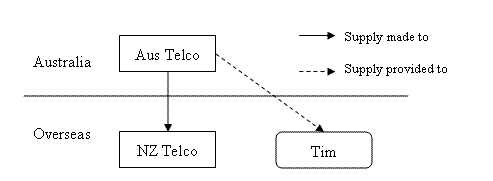
Example 2 - IDD reverse charge call - overseas person is reverse charged for a call from Australia - use of Australian telecommunication supplier's network
24. Jacqui is an Australian resident who uses her home telephone to reverse charge a call to a friend, Peter, in New Zealand. Peter is charged by NZ Telco for accepting the call. Aus Telco makes a supply of interconnection services to NZ Telco and charges a fee.
25. The supply of interconnection services made by Aus Telco to NZ Telco (a non-resident which is not in Australia) is GST-free under item 2.
26. The actual flow of the supply of interconnection services made by Aus Telco under an agreement entered into with NZ Telco is provided to Peter, a subscriber who agrees to accept the call and charge made through the reverse charge service. Peter is not in Australia when the supply is made. Therefore, subsection 38-190(3) does not negate the GST-free status of the supply covered by item 2.

Example 3 - Global Roaming - employee of Australian subscriber is overseas - makes and receives calls - use of Australian telecommunication supplier's network
27. An Australian resident company, Aus Co, has a mobile phone agreement with Aus Telco. Greg, an employee of Aus Co, travels to China for business. Greg has a work mobile provided by Aus Co that is supplied under a mobile phone agreement with Aus Telco.
28. While in China Greg accesses the mobile service through a Chinese Telecommunication supplier (China Telco) and uses his work mobile to make a call to and receive a call from a business contact in Australia, Leanne.
29. The call is routed through China Telco. China Telco has an interconnection agreement with Aus Telco. Aus Telco makes a supply of interconnection services to China Telco and charges a fee.
30. The supply of the interconnection services made by Aus Telco to China Telco (a non-resident which is not in Australia) is GST-free under item 2.
31. The supply of interconnection services made by Aus Telco to China Telco is a supply under an agreement entered into with China Telco; the supply is provided to Greg. Greg is not in Australia when the supply is made. Therefore, subsection 38-190(3) does not negate the GST-free status of the supply.
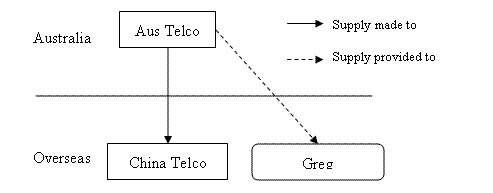
Example 4 - Toll-free calling - made by Australian or overseas customer of Australian company whilst they are overseas
32. An Australian travel agency, Aus Travel Co, has an agreement with NZ Telco for a toll-free calling service. The arrangement allows Australian customers of Aus Travel Co travelling in New Zealand to call the toll-free number and be put through to Aus Travel Co. It also allows its potential customers who are New Zealanders to call Aus Travel Co through the toll-free number.
33. Maria, an Australian resident, books a tour to New Zealand through Aus Travel Co. While in New Zealand there is a problem with the tour. Maria contacts Aus Travel Co using the toll-free number she was given by Aus Travel Co. John, a New Zealand resident, also calls Aus Travel Co from New Zealand to enquire about a proposed tour.
34. Aus Travel Co is charged by NZ Telco for the toll-free calling service, including a fee for setting up the toll-free arrangement, a monthly fee and any additional usage charges.
35. NZ Telco and Aus Telco have an interconnection agreement. Aus Telco makes a supply of interconnection services to NZ Telco and charges a fee.
36. The supply of interconnection services satisfies the requirements of item 2 of subsection 38-190(1) and is, therefore, a supply covered by item 2.
37. The supply of interconnection services by Aus Telco to NZ Telco is a supply under an agreement entered into with a non-resident. Paragraph 38-190(3)(a) is therefore satisfied.
38. The interconnection services are provided to the NZ Telco's toll-free number subscriber, Aus Travel Co. Aus Travel Co accepts the obligation to pay for the calls and the actual flow of the supply of interconnection services is to Aus Travel Co. Aus Travel Co is in Australia when the interconnection services are performed. Therefore, the supply is provided to Aus Travel Co in Australia. Paragraph 38-190(3)(b) also is satisfied.
39. As a result, subsection 38-190(3) applies to the interconnection services supply covered by item 2 of subsection 38-190(1) and its GST-free status is negated.
40. The supply of interconnection services made by Aus Telco to NZ Telco is therefore a taxable supply.
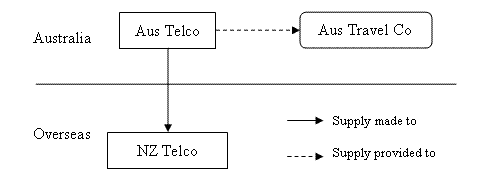
Example 5 - Toll-free calling - made by customer of an overseas company whilst they are in Australia
41. A New Zealand travel agency (NZ Travel Co) has an agreement with NZ Telco for a toll-free calling service. The arrangement allows the customers of NZ Travel Co on holiday in Australia to call the toll-free number and connect to the NZ Travel Co.
42. Judy books a tour to Australia through NZ Travel Co. While in Australia Judy contacts NZ Travel Co using the toll-free number to discuss a problem with the tour.
43. NZ Travel Co is charged by NZ Telco for the toll-free calling service, including a fee for setting up the toll-free arrangement, a monthly fee and any additional usage charges.
44. NZ Telco and Aus Telco have an interconnection services agreement. Aus Telco makes a supply of interconnection services to NZ Telco and charges a fee.
45. The supply of the interconnection service made by Aus Telco to NZ Telco (a non-resident which is not in Australia) is GST-free under item 2.
46. The supply of the interconnection services made by Aus Telco under an agreement with NZ Telco is provided to NZ Telco's toll-free number subscriber, NZ Travel Co. NZ Travel Co is not in Australia when the supply is made. Therefore, subsection 38-190(3) does not negate the GST-free status of the interconnection services supply.
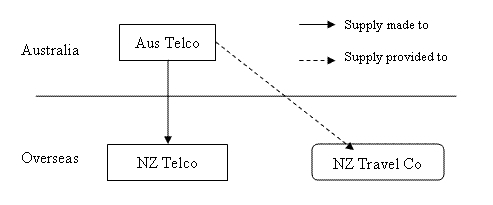
Example 6 - International call-backs - Australian customer makes international calls via call-back service - use of Australian telecommunications supplier's network
47. Carolyn is an Australian resident. Carolyn has a contract with a non-resident call-back telecommunication company (NR Call-back Telco) to make international telephone calls from Australia. Carolyn dials NR Call-back Telco's access number and enters the details of the international telephone number of her friend, Cindy. Carolyn then hangs up her telephone. The NR Call-back Telco calls back Carolyn prompting her to complete the call by entering the international destination number.
48. NR Call-back Telco has an interconnection services agreement with Aus Telco. Aus Telco makes a supply of interconnection services to NR Call-back Telco and charges a fee.
49. The supply of interconnection services made by Aus Telco to NR Call-back Telco (a non-resident which is not in Australia) is covered by item 2.
50. The supply of interconnection services made by Aus Telco under an agreement entered into with NR Call-back Telco is provided to NR Call-back Telco's subscriber, Carolyn.
51. As the supply is provided to Carolyn who is in Australia when the services are performed, subsection 38-190(3) applies to the supply to negate its GST-free status. The supply of interconnection services made by Aus Telco to NR Call-back Telco is therefore a taxable supply.
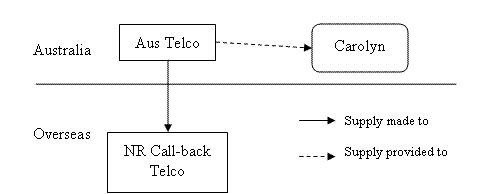
Example 7 - International call directed through Australia - overseas person makes a call, directed through Australia, to a person in another country - use of Australian telecommunication supplier's network
52. Leone, a resident of Belgium, is a subscriber to Belgium Telco (a Belgian resident telecommunication supplier). She subscribes to the IDD facility offered by Belgium Telco. Leone makes a call to Tony in Papua New Guinea. The call is routed via Aus Telco. Aus Telco has an interconnection services agreement with Belgium Telco. Aus Telco makes a supply of interconnection services to Belgium Telco and charges a fee.
53. The supply of the interconnection service made by Aus Telco to Belgium Telco (a non-resident which is not in Australia) is GST-free under item 2.
54. The actual flow of the supply of the interconnection services made by Aus Telco under an agreement entered into with Belgium Telco is to their subscriber Leone. Leone is not in Australia when the supply is made. Therefore, subsection 38-190(3) does not negate the GST-free status of the supply covered by item 2.
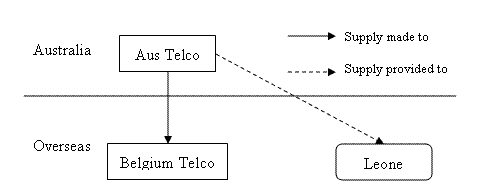
Example 8 - Facilities managed call centre services - made by an Australian telecommunications supplier to a non-resident
55. Aus Telco has an agreement with Konnichiha Airlines to provide call centre services whereby Aus Telco receives calls from Konnichiha Airlines' customers and provides call distribution and reservation services.
56. Prospective passengers in Japan call Konnichiha Airlines to book flights. Their calls are directly routed to Konnichiha Airlines' call centre in Australia where a customer service representative makes the reservation. Aus Telco charges Konnichiha Airlines for this service.
57. The supply of call centre services made by Aus Telco to Konnichiha Airlines (a non-resident company that is not in Australia) is GST-free under item 2.
58. The supply of call centre services involves receiving telephone calls, providing information and making reservations for Konnichiha Airlines and as such the supply is made and provided to Konnichiha Airlines. While prospective customers receive information and make reservations, they are not provided with the service of a facilities managed call centre service. This is provided to Konnichiha Airlines.[11]
59. Because the supply is made and provided to Konnichiha Airlines which is not in Australia when the supply is made, subsection 38-190(3) does not negate the GST-free status of the supply covered by item 2.
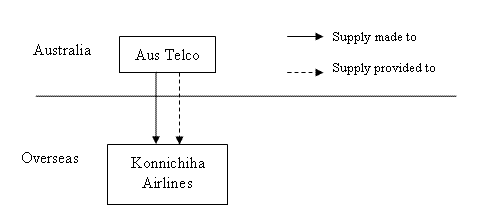
Example 9 - Voice over Internet Protocol (VoIP) call - made by non-resident in Australia to Australian resident and to overseas - use of the Australian telecommunication supplier's network
60. Denis, a New Zealand resident, has a contract with NZ Telco for internet access which includes VoIP calls. Denis is travelling in Australia when he makes a VoIP call from a device that is not portable, to his friend Graeme, who lives in Australia. Denis also makes a VoIP call to his daughter Mary who lives in New Zealand.
61. Aus Telco and NZ Telco have an interconnection services agreement. Aus Telco makes a supply of interconnection services to NZ Telco and charges a fee.
62. The supply of the interconnection service made by Aus Telco to NZ Telco (a non-resident which is not in Australia) is covered by item 2.
63. The supply of the interconnection services made by Aus Telco under an agreement entered into with NZ Telco is provided to NZ Telco's internet subscriber, Denis.
64. Denis is in Australia when the services are performed and his presence in Australia is integral to the provision of the supply. Subsection 38-190(3) applies to the supply covered by item 2 and the GST-free status of the supply is negated.
65. In addition, as a portable device is not used to make the VoIP call, subsection 38-570(1) does not apply to the telecommunication supply to make it GST-free.[12]
66. The supply of interconnection services made by Aus Telco to NZ Telco is therefore a taxable supply.
67. Where there is no consideration for the supply between the NZ Telco and its customer Denis, this will not change the GST treatment of the supply that the Aus Telco makes to the NZ Telco.
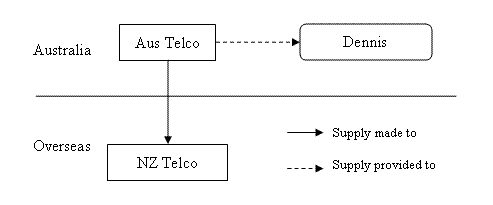
Example 10 - Satellite telephone - overseas person using an Australian satellite phone calls another overseas person from a ship outside Australia - use of the Australian telecommunication supplier's network
68. Aus Telco supplies Carmel, a Fijian resident, with a satellite phone for use on her private yacht. Carmel uses the satellite phone to call a friend in New Zealand while on a trans-Tasman crossing. The call is routed via the Aus Telco's network in Australia. The call is made by Carmel from a ship outside Australia. The billing address for the satellite phone service is Carmel's address in Fiji.
69. The supply of the telecommunication service made by Aus Telco to Carmel (a non-resident who is not in Australia) is GST-free under item 2.
70. The supply of telecommunication services made by Aus Telco under an agreement entered into with Carmel is made and provided to her outside Australia. Therefore, subsection 38-190(3) does not apply to negate the GST-free status of the supply.
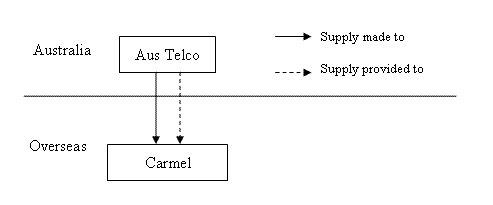
Example 11 - Satellite telephone - overseas person calls another overseas person who is on a ship outside Australia - call is routed through Australian telecommunication supplier
71. Brad is a resident of Guam and a subscriber of Guam Telco. Guam Telco is a non-resident that is not in Australia. Brad calls his friend who is on a cruise around the Pacific Islands. The call is routed through Aus Telco's network and via satellite to the ship. Aus Telco has an interconnection services agreement with Guam Telco. Aus Telco makes a supply of interconnection services to Guam Telco and charges a fee.
72. The supply of the interconnection services made by Aus Telco to Guam Telco is GST-free under item 2.
73. The actual flow of the supply of the interconnection services made by Aus Telco under an agreement entered into with Guam Telco is provided to Brad. Brad is not in Australia when the supply is made. Therefore, subsection 38-190(3) does not negate the GST-free status of the supply covered by item 2.
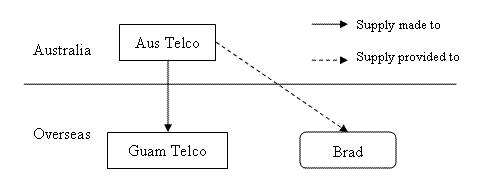
Example 12 - Video Conference Interconnection Services - Australian telecommunication supplier supplies video conferencing to overseas telecommunication company
74. A New Zealand company (NZ Co) contracts with NZ Telco (a non-resident which is not in Australia) for video conferencing services between its sales staff in New Zealand and a potential customer in Australia (Aus Target Co). NZ Co is the registered contact and chair person for the video conference. It is the subscriber to the video conferencing service including the related video conferencing facilities. In order to provide the video conference service, NZ Telco obtains access to a bridge (a facility using interconnection software that is part of the overall telecommunication service) supplied by Aus Telco in Australia. NZ Co and Aus Target Co dial the bridge to start the video conference. In addition, both NZ Telco and Aus Telco provide video conference facilities (a room) for a separate fee. The room is integral to the supply of the video conferencing service.
75. The supply of video conferencing services and facilities is a GST-free supply under item 2.
76. The supply of video conferencing services and facilities made by Aus Telco under an agreement entered into with NZ Telco is provided to NZ Telco's customer NZ Co. NZ Co is the entity that has the contract with NZ Telco for the supply of the video conferencing services and facilities. NZ Co is not in Australia when the supply is made. Therefore subsection 38-190(3) does not negate the GST-free status of the supply covered by item 2.
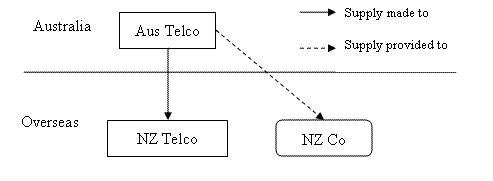
Example 13 - Regional Telecommunication Service - overseas telecommunication company subcontracts with an Australian telecommunications supplier to provide necessary Australian telecommunication supplies
77. A New Zealand company (NZ Co) enters into an arrangement with NZ Telco (a non-resident which is not in Australia) for the provision of trans-Tasman telecommunication supplies - it is the subscriber in relation to that telecommunications supply. The supply is a regional telecommunication service which allows NZ Co and Aus Co (the Australian resident member of the NZ Co group) to make or receive voice, data or other telecommunication services. NZ Telco contracts with Aus Telco to provide the necessary Australian telecommunication supplies, which are interconnection services.
78. The supply of the interconnection services made by Aus Telco to NZ Telco is GST-free under item 2.
79. The supply of interconnection services made by Aus Telco under an agreement entered into with NZ Telco is provided to NZ Co, NZ Telco's subscriber. NZ Co is not in Australia when the supply is made. Therefore, subsection 38-190(3) does not negate the GST-free status of the supply covered by item 2.
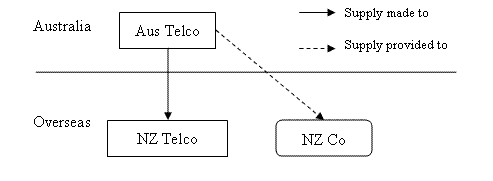
Date of effect
80. This Determination applies both before and after its date of issue. However, this Determination will not apply to taxpayers to the extent that it conflicts with the terms of a settlement of a dispute agreed to before the date of issue of this Determination (see paragraphs 75 and 76 of Taxation Ruling TR 2006/10).
Commissioner of Taxation
6 June 2012
Appendix 1 - Your comments
81. You are invited to comment on this draft Determination including the proposed date of effect. Please forward your comments to the contact officer by the due date.
82. A compendium of comments is prepared for the consideration of the relevant Rulings Panel or relevant tax officers. An edited version (names and identifying information removed) of the compendium of comments will also be prepared to:
- •
- provide responses to persons providing comments; and
- •
- be published on the ATO website at www.ato.gov.au
Please advise if you do not want your comments included in the edited version of the compendium.
| Due date: | 6 July 2012 |
| Contact officer details have been removed following publication of the final determination. | |
Footnotes
Other issues dealt with in the issues register are addressed in GSTD 2012/D2; GSTD 2012/D3 and GSTD 2012/D4.
All legislative references are to the GST Act unless otherwise indicated.
The meaning of 'not in Australia' for the purposes of subsection 38-190(1) is explained in Goods and Services Tax Ruling GSTR 2004/7 Goods and services tax: in the application of items 2 and 3 and paragraph (b) of item 4 in the table in subsection 38-190(1) of the A New Tax System (Goods and Services Tax) Act 1999:
- •
- when is a 'non-resident' or other 'recipient' of a supply 'not in Australia when the thing supplied is done'?
- •
- when is 'an entity that is not an Australian resident' 'outside Australia when the thing supplied is done'?
Defined in section 195-1 as 'anything that can be supplied or imported'.
The meaning of 'work physically performed on goods' and 'directly connected with goods or real property' is discussed in Goods and Services Tax Ruling GSTR 2003/7: what do the expressions 'directly connected with goods or real property' and 'a supply of work physically performed on goods' mean for the purposes of subsection 38-190(1) of the A New Tax System (Goods and Services Tax) Act 1999?
Item 2 is also subject to subsection 38-190(2) however this limitation is not relevant for present purposes.
Goods and Services Tax Ruling GSTR 2005/6 Goods and services tax: the scope of subsection 38-190(3) and its application to supplies of things (other than goods or real property) made to non-residents that are GST-free under item 2 in the table in subsection 38-190(1) of the A New Tax System (Goods and Services Tax) Act 1999. The meaning of 'a supply is provided to another entity' is explained at paragraphs 220-225.
'Determining whether the supply is provided to that other entity in Australia' is explained at paragraphs 323 - 425 of GSTR 2005/6.
The meaning of the supply being provided to the entity in Australia when the thing supplied is done is explained in GSTR 2005/6 at paragraphs 83 - 136.
In all the examples:
- •
- the supply of the interconnection services is neither a supply of work physically performed on goods situated in Australia when the work is done nor a supply directly connected with real property situated in Australia;
- •
- the non-resident Telco acquires the interconnection services in carrying on its enterprise; and
- •
- the non-resident Telco is not registered or required to be registered for GST in Australia.
The GST treatment in relation to example 8 is not necessarily indicative of the treatment of a range of other supplies that may be delivered through call centre arrangements. It is necessary to identify what is being supplied through a call centre to determine the GST treatment of a supply. This is illustrated in comparing example 34 and example 35 in GSTR 2005/6.
In respect of portable devices and global roaming services in the context of section 38-570 see GSTD 2012/D4.
This Draft Determination has been finalised by GSTD 2012/7
Not previously issued as a draft
References
ATO references:
NO 1-3WWFS7C
Related Rulings/Determinations:
TR 2006/10
GSTD 2012/D2
GSTD 2012/D3
GSTD 2012/D4
GSTR 2003/7
GSTR 2004/7
GSTR 2005/6
Subject References:
goods and services tax
GST free
non-resident entities
non-resident individuals
telecommunication supply
Legislative References:
ANTS(GST)A 1999 38-190
ANTS(GST)A 1999 38-190(1)
ANTS(GST)A 1999 38-190(1) item 2
ANTS(GST)A 1999 38-190(2)
ANTS(GST)A 1999 38-190(3)
ANTS(GST)A 1999 38-190(3)(a)
ANTS(GST)A 1999 38-190(3)(b)
ANTS(GST)A 1999 38-570(1)
ANTS(GST)A 1999 195-1
TAA 1953 Sch 1 105-60
Broadcasting Services Act 1992 Sch 5
Telecommunications Act 1997
Other References:
The Telecommunications Industry Liaison Group - Issues Register
